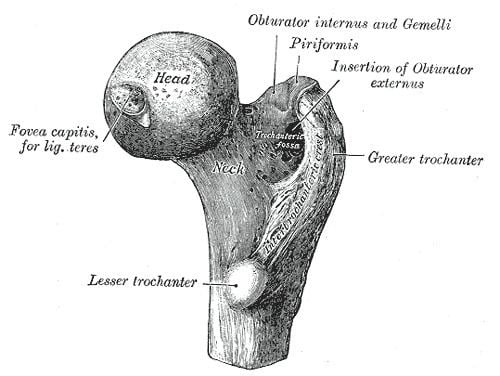Origins Vastus lateralis TA A02.5.04.005 | Latin trochanter major FMA 32852 | |
 | ||
Insertions Obturator internus, gemelli, piriformis, gluteus minimus, Gluteus medius | ||
The greater trochanter (great trochanter) of the femur is a large, irregular, quadrilateral eminence and a part of the skeletal system.
Contents
It is directed lateral and medially and slightly posterior. In the adult it is about 1 cm lower than the head. Because the pelvic outlet in the female is larger than in the male, there is a greater distance between the greater trochanters in the female.
It has two surfaces and four borders. It is a traction epiphysis.
Surfaces
The lateral surface, quadrilateral in form, is broad, rough, convex, and marked by a diagonal impression, which extends from the postero-superior to the antero-inferior angle, and serves for the insertion of the tendon of the gluteus medius.
Above the impression is a triangular surface, sometimes rough for part of the tendon of the same muscle, sometimes smooth for the interposition of a bursa between the tendon and the bone. Below and behind the diagonal impression is a smooth, triangular surface, over which the tendon of the gluteus maximus lays, a bursa being interposed.
The medial surface, of much less extent than the lateral, presents at its base a deep depression, the trochanteric fossa (digital fossa), for the insertion of the tendon of the obturator externus, and above and in front of this an impression for the insertion of the obturator internus and superior and inferior gemellus muscles.
Borders
The superior border is free; it is thick and irregular, and marked near the center by an impression for the insertion of the piriformis.
The inferior border corresponds to the line of junction of the base of the trochanter with the lateral surface of the body; it is marked by a rough, prominent, slightly curved ridge, which gives origin to the upper part of the vastus lateralis.
The anterior border is prominent and somewhat irregular; it affords insertion at its lateral part to the glutæus minimus.
The posterior border is very prominent and appears as a free, rounded edge, which bounds the back part of the trochanteric fossa.
